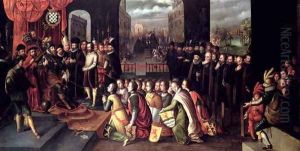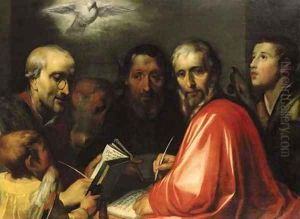Gerrit Pietersz Paintings
Gerrit Pietersz, also known as Gerrit Pietersz Sweelink, was a Dutch Renaissance painter who lived and worked during the late 16th and early 17th centuries. Born in 1566 in Amsterdam, he was part of a family of artists; his father Pieter Gerritsz was a painter, and his brother, Jan Pieterszoon Sweelinck, became a renowned organist and composer. Gerrit Pietersz is less well-documented than his brother, and as such, his life and works have not been as thoroughly researched or preserved.
While specific details of his training are unclear, it is believed that he was educated in the artistic environment of Amsterdam, which at the time was a burgeoning center for the arts in the Northern Netherlands. Gerrit Pietersz's paintings often included religious subjects, a common theme during the period as the Reformation and Counter-Reformation influenced art production significantly. His style was consistent with Mannerism, which was widespread in Northern Europe at the end of the 16th century.
Unfortunately, unlike his brother Jan, who received considerable fame for his music, Gerrit did not achieve the same level of renown for his art. Records of his works are sparse, and few if any survive to the present day, making it challenging to fully assess his impact on the art world. It is known, however, that he died in 1612 in Amsterdam.
Despite the limited information on Gerrit Pietersz Sweelink's life and oeuvre, he remains a part of the broader narrative of Dutch art history. His life spanned a dynamic period in European history, characterized by significant religious, social, and artistic changes. Even if his individual contributions remain somewhat obscure, his presence in the vibrant Amsterdam art scene of the late 16th century positions him among the many artists who collectively shaped the Dutch Golden Age of painting that would flourish in the following century.

